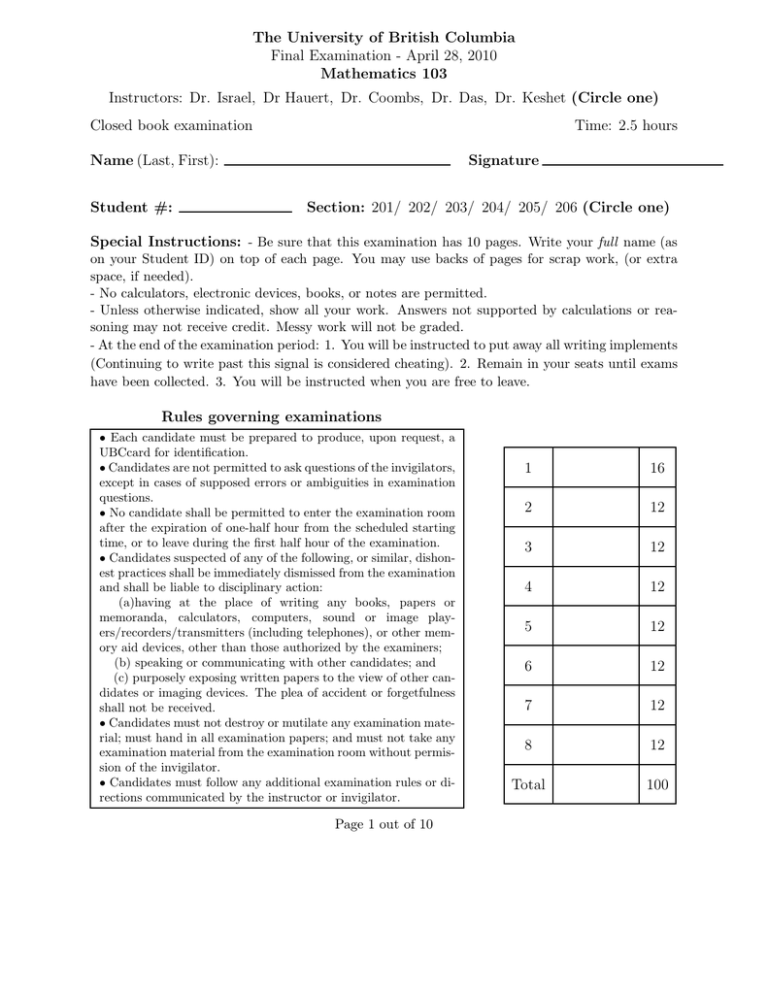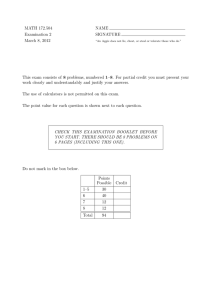The University of British Columbia Final Examination - April 28, 2010
advertisement

The University of British Columbia
Final Examination - April 28, 2010
Mathematics 103
Instructors: Dr. Israel, Dr Hauert, Dr. Coombs, Dr. Das, Dr. Keshet (Circle one)
Closed book examination
Time: 2.5 hours
Name (Last, First):
Student #:
Signature
Section: 201/ 202/ 203/ 204/ 205/ 206 (Circle one)
Special Instructions: - Be sure that this examination has 10 pages. Write your full name (as
on your Student ID) on top of each page. You may use backs of pages for scrap work, (or extra
space, if needed).
- No calculators, electronic devices, books, or notes are permitted.
- Unless otherwise indicated, show all your work. Answers not supported by calculations or reasoning may not receive credit. Messy work will not be graded.
- At the end of the examination period: 1. You will be instructed to put away all writing implements
(Continuing to write past this signal is considered cheating). 2. Remain in your seats until exams
have been collected. 3. You will be instructed when you are free to leave.
Rules governing examinations
• Each candidate must be prepared to produce, upon request, a
UBCcard for identification.
• Candidates are not permitted to ask questions of the invigilators,
except in cases of supposed errors or ambiguities in examination
questions.
• No candidate shall be permitted to enter the examination room
after the expiration of one-half hour from the scheduled starting
time, or to leave during the first half hour of the examination.
• Candidates suspected of any of the following, or similar, dishonest practices shall be immediately dismissed from the examination
and shall be liable to disciplinary action:
(a)having at the place of writing any books, papers or
memoranda, calculators, computers, sound or image players/recorders/transmitters (including telephones), or other memory aid devices, other than those authorized by the examiners;
(b) speaking or communicating with other candidates; and
(c) purposely exposing written papers to the view of other candidates or imaging devices. The plea of accident or forgetfulness
shall not be received.
• Candidates must not destroy or mutilate any examination material; must hand in all examination papers; and must not take any
examination material from the examination room without permission of the invigilator.
• Candidates must follow any additional examination rules or directions communicated by the instructor or invigilator.
Page 1 out of 10
1
16
2
12
3
12
4
12
5
12
6
12
7
12
8
12
Total
100
April 2010
Math 103
Name:
Page 2 out of 10
Problem 1: Multiple Choice Questions: Circle ONE correct answer
(a, b, c, d, or e). There is no partial credit in this question.
1: To
Z 1which of the following integrals does the Fundamental Theorem of Calculus apply?
cos(x)
(a)
dx
ln(x)
−1
Z 1
cos(x)
dx
(b)
x
−1
Z 1
cos(x)
√
(c)
dx
x+1
Z−11
cos(x)
dx
(d)
2
−1 x + 1
(e) None of the above.
2: To find the integral
Z
x2 e2x dx using integration by parts, the best choice for u and dv
in the first step would be
(a) u = x, dv = xe2x dx
(b) u = x2 , dv = e2x dx
(c) u = xe2x , dv = x dx
(d) u = e2x , dv = x2 dx
(e) u = x, dv = e2x dx
3: The expression S3 = 1 + x3 +
(a) sin(x3 )
3
(b) cos(x 2 )
(c) cos(x)
(d) cos(x3 )
3
(e) ex
x6
2
is the first three terms of a Taylor series for:
4: Which of the following series converges?
∞
∞
∞
X
X
X
1
k −2 (b) S =
(a) S =
k
(c) S =
k
k=1
k=1
k=1
(d) S =
∞
X
k=0
(1.01)k
(e) S =
∞
X
k=0
k2
April 2010
Math 103
Name:
Page 3 out of 10
Problem 1, Cont’d from page 2:
5: Which
the following improper integrals converges?
Z of
∞
(a) I =
e3x dx
1
Z ∞
−5
(b) I = 10 ·
x−1 dx
1
Z ∞
−1/2
(c) I =
x
dx
Z1 ∞
(d) I =
x−2 dx
Z 1∞ 2
x
(e) I =
dx
1000
1
6: A continuous random variable X has a probability density of the form
f (x) = Ax + Bx2 ,
for
−1 ≤x≤1
where A and B are constants. The values of A and B should be
(a) A = 1, B = 1
(b) A = 1, B = 3/2
(c) A = 0, B = 3/2
(d) A = 0, B = 2/3
(e) A = 2, B = 3
7: A random variable X can take on one of the values {1, 3, 5} with (discrete) probabilities
p(1) = 1/2, p(3) = 1/4, p(5) = 1/4. The mean value of X is then
(a)
5
2
(b) 9
(c) 3
(d)
2
5
(e) 1
dy
= 1 − 4y 2 and initial condition y(0) = 0. After a
dt
long time (when y no longer changes), the value of y is
8: Consider the differential equation
(a) y = 0
(b) y = 1 (c) y = 1/4 (d) y = 4 (e) y = 1/2
April 2010
Math 103
Name:
Page 4 out of 10
Problem 2:
(a) Calculate the area of the bounded region enclosed by the curves f (x) = x3 − 4x and
g(x) = −x2 + 2x for x ≥ 0.
April 2010
Math 103
Name:
Page 5 out of 10
Problem 3: A toxic chemical has been spilled somewhere on a 100 km stretch of highway.
The probability that the spill occurred within x km of the factory is shown in the top panel
of Figure 1.
1.0
0.9
0.8
0.7
0.6
0.5
0.4
0.3
0.2
0.1
0.0
0
25
50
75
100
x
Figure 1: Plot and grid for Problem 3
(a) Plot the probability density p(x) for the location of the spill in the grid provided on the
bottom panel. (You do not need to provide a scale on the y axis.)
(b)What is/are the most probable location(s) of the spill?
April 2010
Math 103
Name:
Page 6 out of 10
Problem 4: Compute the following integrals. (Leave your answers in terms of e or ln().)
Z 9 √
(a) I =
e x dx
4
(b) I =
Z
e2
e
(c) I =
Z
0
1
1
dx
x ln(x)
x
dx
(2 − x)(1 + 2x)
April 2010
Math 103
Name:
Page 7 out of 10
Problem 5: In this problem, you are asked to find a value for the integral
Z 1
I=
x cos(x) dx
0
in two different ways.
(a) Use one of the integration techniques to compute the above integral directly. (Leave your
answer in terms of sines and cosines of some number.)
(b) Use the Taylor series for the function cos(x) to write down a Taylor Series approximation
for x cos(x) and find an approximation to the integral I using the first 3 terms of that series.
(Leave your answer in terms of the three fractions, i.e. you need not compute a simplified
fraction nor a decimal approximation. See footnote1 for some factorial values.)
1
2! = 2, 3! = 6, 4! = 24, 5! = 120, 6! = 720, 7! = 5040
April 2010
Math 103
Name:
Page 8 out of 10
Problem 6: The height of fluid, h(t) in a cylindrical container is controlled by a pump so
that it satisfies the differential equation
dh
= −kh1/3 ,
dt
h(0) = h0
where k > 0, h0 > 0 are constants, and h0 is the initial height of the fluid.
(a) Solve this differential equation to determine the height h(t) at any later time t.
(b) At what time will the container be empty?
April 2010
Math 103
Name:
Page 9 out of 10
Problem 7: The probability that a newly divided cell will divide again before t hours
(where t ≥ 0) is given by
F (t) = 1 − e−t/12
(a) If you start observing a cell immediately after a division, how long, on average, would
you have to wait to see the next division?
(b) What is the probability that the cell will divide between 3 and 6 hours? (Leave your
answer in terms of e.)
(c) What is the median division time?
April 2010
Math 103
Name:
Page 10 out of 10
Problem 8: The graph of the function
y = f (x) = x(1 − x),
0 ≤ x ≤ 0.5
is rotated about the y axis to form a trumpet shape whose base is at (0,0). Determine
the volume of fluid that can be contained inside this shape. (Hint: One way to solve this
problem is to find the function x = g(y) that describes the same curve and use it to set up
the appropriate integral.)
